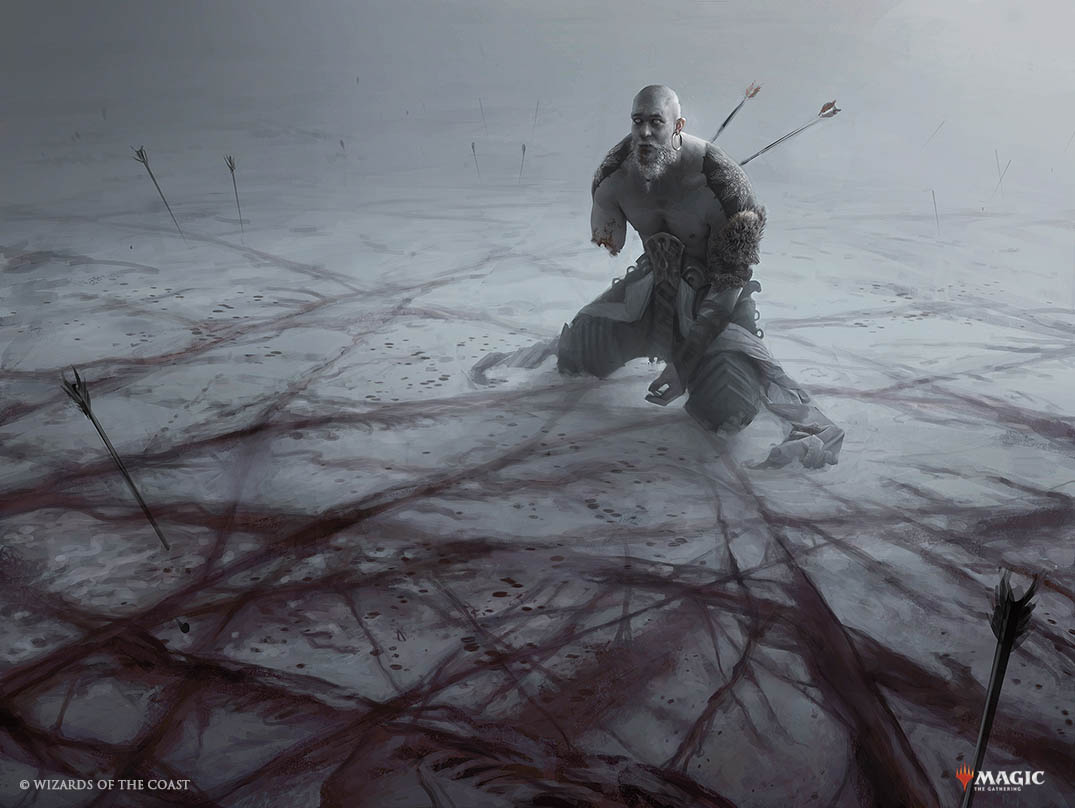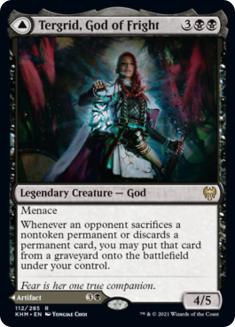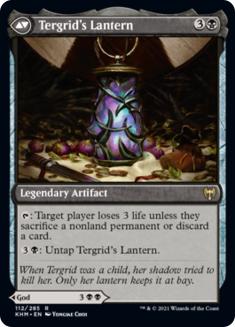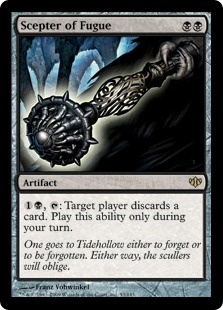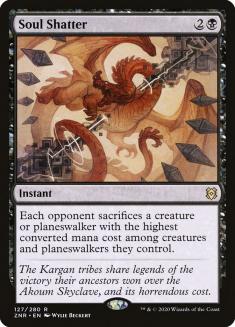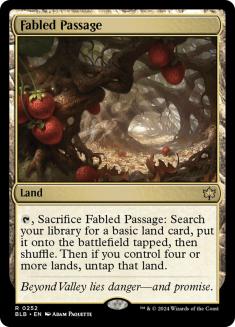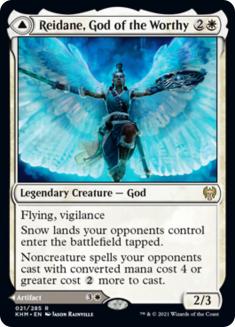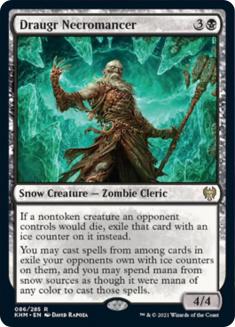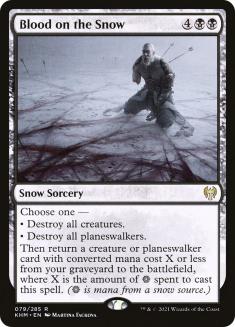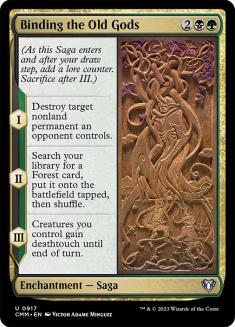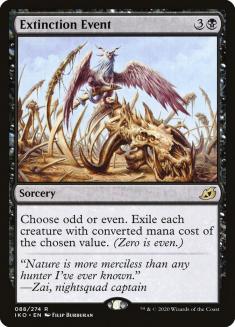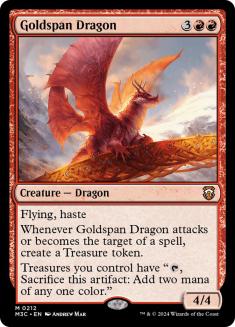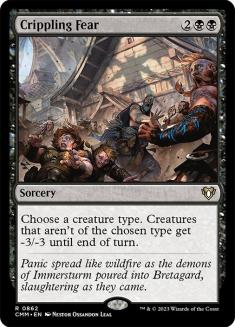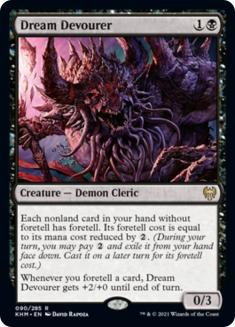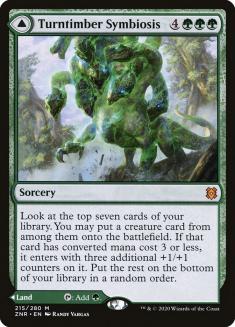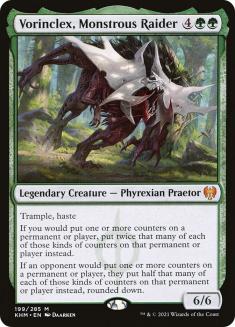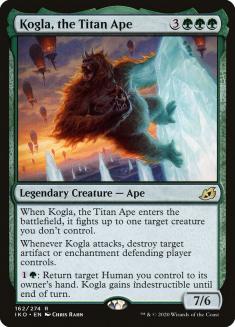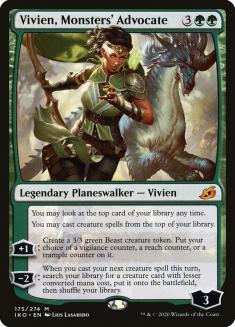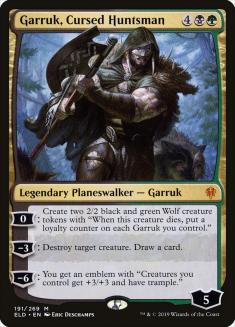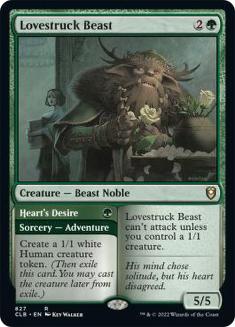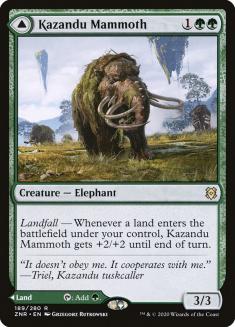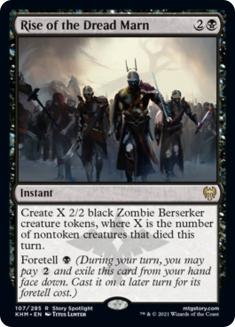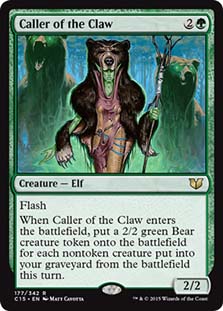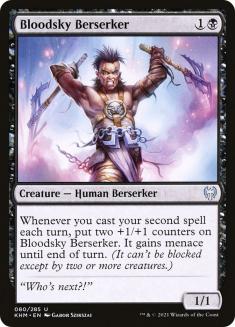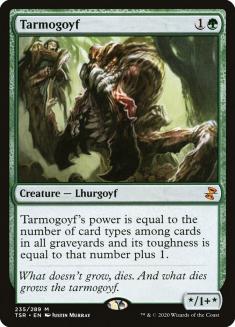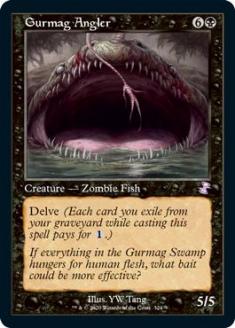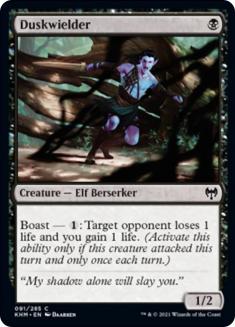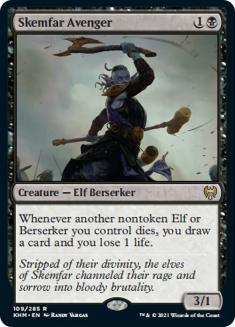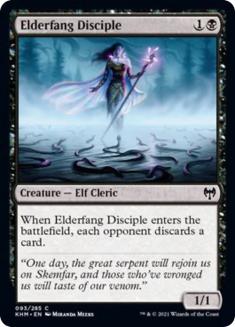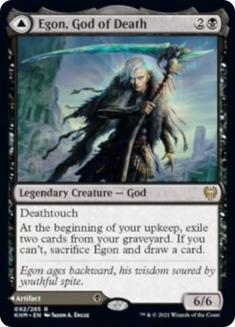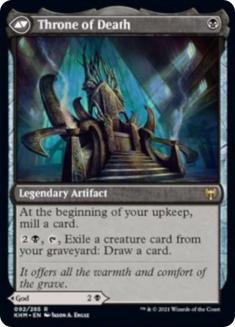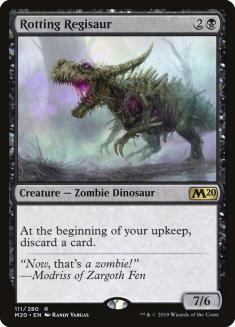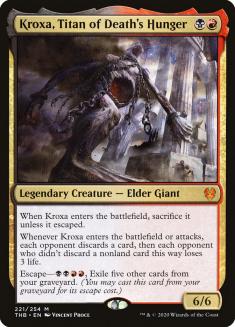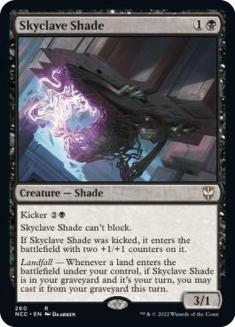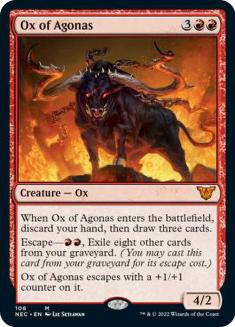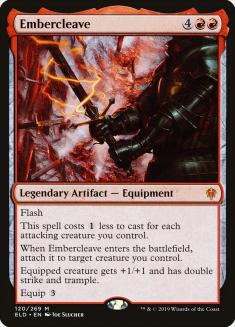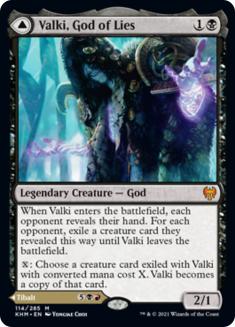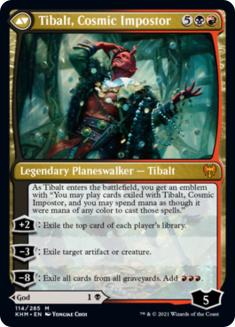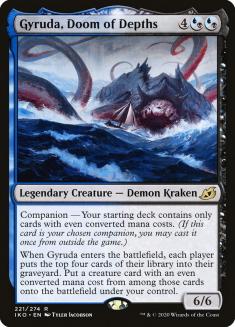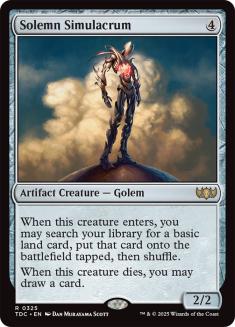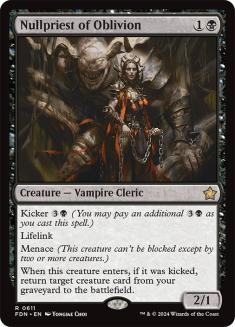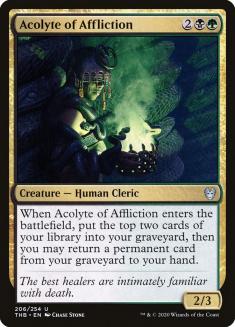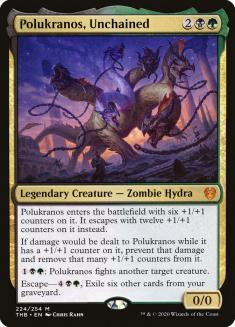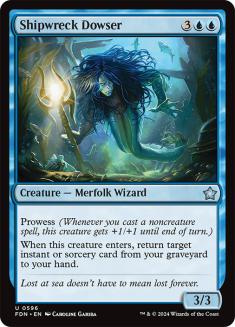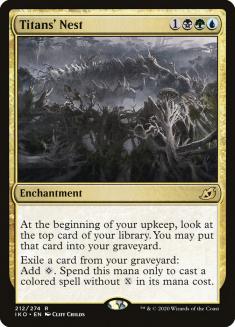The black cards of Kaldheim are an interesting mix. The spot removal leaves a lot to be desired, but there are a lot of creatures capable of generating advantage and a lot of graveyard synergies. There’s also one very, very big card that will immediately help define Standard that we’ll get to.
First, however, be sure to check out my top 10 white cards and top 10 blue cards if you missed them.
And now, a potential sleeper…
10. Tergrid, God of Fright // Tergrid’s Lantern
On the surface, Tergrid seems like it should hardly be worth a second thought. After all, a 4/5 for five with no automatic card advantage or protective abilities? And then the backside is a punishing card, making your opponent choose between losing three life, sacrificing a permanent, or discarding a card?
Okay, first of all, Tergrid makes more sense when you think of it as the back side with an option to buy the front side. The front can be incredibly impactful in the right spots if it sticks, but it’s not reliable the way the back side is.
Reliable? Isn’t the back side a punisher card?
It is, but hear me out. First, let’s consider the options:
- Lose 3 life
- Sacrifice a permanent
- Discard a card
How much are these options worth? Well, setting aside tactical considerations (which are especially relevant on a punisher card, but just to get a baseline), we’re talking about three modes that are all kind of worth a card. “Sacrifice a permanent” or “discard a card” are both clearly a “card,” albeit one whose value really depends on the circumstances.
Losing three life might not be worth a card if you can only do it once; however, when you’re playing a Lava Spike deck, all you want are more Lava Spikes.
When Tergrid’s Lantern is giving you a virtual card every turn, your opponent usually won’t be able to choose to get Lava Spiked every turn for long, assuming you’re playing fairly aggressively. The more you can make losing three life a bad option, the stronger your ability to squeeze your opponent with the rock-and-a-hard-place options of discarding a card or sacrificing a nonland permanent. Of course, the more cards you discard, the more painful it is to discard more cards, and the more nonland permanents you sacrifice, the more painful it is to sacrifice more permanents.
What if Tergrid’s Lantern was just “3B, Tap to make the opponent lose 3 life” by itself? That’s kind of a three-power unblockable, haste creature that’s very hard to kill, which is kind of amazing for four mana, right?
What about “3B, Tap to make the opponent discard a card” instead? That’s the same cost in mana as Scepter of Fugue for one activation, but from there, every activation is free. What’s more, they can’t even “get out of it” by having no cards in hand, since at that point, they have to sacrifice permanents or lose life.
And “3B, Tap to make the opponent sacrifice a nonland permanent” to finish? That’s incredibly mana-efficient in general, and they can’t even get out of it by having only lands on the battlefield.
All three options are quite strong for a zero-cost activation, but they are spread out enough that it’s hard to keep all three options really bad for your opponent at the same time. The more times you can activate the Lantern, the stronger it gets…
…which brings us to its other ability:
3B: Untap Tergrid’s Lantern.
This means we’re not only getting some kind of a card every turn, we’ve always got the option to double up (or possibly even triple up, if things really stretch). This is a really devastating attack on your opponent’s resources, particularly if your opponent is playing a lot of creature and/or planeswalker removal.
As for Tergrid itself, the amount of impact it has really depends on the rest of your deck and how much discard/force-sacrifice you’ve got. Of course, one of the best ways to get a lot of that kind of stuff is with Tergrid itself, which really helps mitigate the risk of drawing two of this particular legend.
Given how incredible Tergrid can be against opponents with a handful of creature and planeswalker removal, or really anyone trying to accumulate a lot of resources over a lot of turns, the most obvious application is in the sideboard on an aggressive or midrange deck. However, it doesn’t actually need to be a sideboard option.
Creatures (26)
- 1 Rankle, Master of Pranks
- 4 Bonecrusher Giant
- 2 Woe Strider
- 4 Mire Triton
- 3 Kroxa, Titan of Death's Hunger
- 1 Nighthawk Scavenger
- 2 Valki, God of Lies
- 2 Goldspan Dragon
- 2 Tergrid, God of Fright
- 2 Egon, God of Death
- 3 Immersturm Predator
Lands (23)
Spells (11)

Is Soul Shatter really worth it over another Heartless Act or a Bloodchief’s Thirst?
Probably not, but we should learn stuff fairly quickly, and maybe it’s just too bad that it costs three and we cut it quickly, but if the synergy with Tergrid is enough to justify it (perhaps in conjunction with how it lines up against the threats in the format), what we learn could give us a nice edge.
There’s a lot of new stuff from Kaldheim to circle back to, but I did want to take a second to acknowledge the amusing basic land situation.
Why use a couple of Snow-Covered basics? Fabled Passage gives us reasonable ability to find them for the occasional edge case where we Valki someone and steal something that needs snow mana.
That’s pretty edge-case, but so is the possibility of our opponent playing Reidane, God of the Worthy and it actually matters that our Snow-Covered basics enter the battlefield tapped.
Speaking of creatures to Valki that might use snow mana…
9. Draugr Necromancer
A full breakdown of Draugr Necromancer can be found here. The short version is that it’s a 4/4 for four that can totally take over a game if left unchecked. You don’t necessarily need to play all snow, but it helps; besides, Draugr Necromancer being snow itself means it can combo with Frost Augur.
To really capitalize on Draugr Necromancer, we want to make sure our creature kill tends to destroy rather than exile.
Blood on the Snow and Binding the Old Gods are both excellent “bigger” creature kill we can use instead of Extinction Event, and both offer particular utility in a snow deck.
Creatures (12)
Lands (27)
Spells (21)

Why Murderous Rider instead of Eliminate?
Simple: one of the absolute strongest cards in Kaldheim and a defining threat of the new Standard dies to Murderous Rider and not to Eliminate.
More on this fella tomorrow, though.
8. Crippling Fear
Crippling Fear is mostly a sideboard card for largely tribal creature decks that want to go over the top of other creature decks (including non-tribal decks, unlike say Witch’s Vengeance).
There are lots of potential homes for it, though I don’t think it’s necessarily a great sideboard option for the current metagame. There’s just so much ramp, Izzet, fatties, and control. Still, metagames move, so here’s an example of it in action:
Creatures (16)
Lands (22)
Spells (22)

7. Dream Devourer
On the surface, one could imagine using Dream Devourer in Cleric tribal, or perhaps setting up a big turn, or as a big (4/3) threat in a deck that can realistically foretell twice a turn and still make plays. While the body is part of why to go to the trouble, one of the best ways to really take advantage of Dream Devourer is to use it kind of like a Lotus Cobra.
Lotus Cobra, unlike most two-drop accelerators, can potentially make two mana in the same turn, as well as being able to give you some acceleration the turn you cast it, if cast slightly off-curve.
If you play Dream Devourer on Turn 2, you can attack for two with it on Turn 3 and foretell a six-drop that now can be cast on Turn 4 (even if they can answer the Dream Devourer at this point).
Against opponents with removal, you might cast Dream Devourer on Turn 4, immediately foretelling a six-drop or seven-drop for next turn. Even if they kill it, the damage is done.
Turntimber Symbiosis is a great way to get extra high-end threats without getting flooded with them; you just need to make sure you’ve got good creatures to flip.
Vorinclex, Monstrous Raider and Kogla, the Titan Ape are both fantastic threats to ramp into, whether from Dream Devourer, Lotus Cobra, or Binding the Old Gods. They’re also excellent hits for Turntimber Symbiosis, or else why not just play a bunch of planeswalkers as part of our threat base?
Having Turntimber Symbiosis doesn’t mean we can have any of the planeswalker action, so with tuning, we could easily end up moving some of those in, particularly since we’ve got enough amazing three-drops, we’re pretty likely to get a Symbiosis.
There are lots of alternatives worth considering, but I wanted to start with Lovestruck Beast and Kazandu Mammoth on account of their perfect curve with The Great Henge, which in turn helps support the Vorinclex / Kogla plan. Here’s an example of the strategy in action:
Creatures (27)
- 4 Lotus Cobra
- 4 Lovestruck Beast
- 3 Kogla, the Titan Ape
- 4 Tangled Florahedron
- 4 Kazandu Mammoth
- 4 Vorinclex, Monstrous Raider
- 4 Dream Devourer
Lands (21)
Spells (12)

6. Rise of the Dread Marn
Rise of the Dread Marn is another sideboard option with maindeck possible chances. First of all, it kind of completely undoes sweepers. Through this lens, it’s kind of a Caller of the Claw.
You don’t get a 2/2 up front, but you do get an extra 2/2 for every opposing creature to die this turn. That’s kind of huge, actually. Like, obviously it doesn’t help you that much more against sweepers (usually), but is that even where you need the help? What it does do is make the card fantastic against anyone foolish enough to block. If you attack with a creature and they block and trade, now you’re getting two 2/2s across two bodies. That’s already a pretty good deal, and it’s not unreasonable to get four or more.
That it has foretell isn’t that big of a deal, but it does help obfuscate other foretell cards. More importantly, however, it’s the perfect example of a foretell card you’d want to have open without needing to have all that mana available. Against sweepers, you only need to leave one open to keep yourself covered. Interestingly, the interaction with sweepers is so strong, it’s not unreasonable to think we might just want to combine it with sweepers of our own!
My first thought as to how to use it maindeck, however, is to capitalize on the Berserker half of the tokens’ types.
5. Bloodsky Berserker
As far as Berserkers go, Bloodsky Berserk is definitely an exciting one. After all, with even just a single one-drop, you’re already up to 3/3 with good chances to grow to 5/5. This card scales so well with cheap spells, I think we’re gonna see a fair bit of it in formats a little bigger than Standard. It’s got a little bit of Tarmogoyf / Gurmag Angler in its DNA.
As for Berserker tribal, the challenge here is the lack of one-drop Berserkers.
Are we really supposed to play Duskwielder? Maybe, but it’s not exactly the most efficient creature if we draw it without one of our tribal rewards.
Creatures (22)
- 2 Kroxa, Titan of Death's Hunger
- 4 Serrated Scorpion
- 4 Whisper Squad
- 2 Arni Brokenbrow
- 2 Dragonkin Berserker
- 4 Bloodsky Berserker
- 4 Skemfar Avenger
Lands (21)
Spells (17)

There’s potential here, but it’s just so hard to fit everything you’d want into these Rakdos decks, and this list doesn’t even have Dragons, nor self-mill.
Maybe it’s the wrong axis to push, but there is a lot of appeal to both The Bloodsky Massacre (which we’ll return to later this week) and Skemfar Avenger.
4. Skemfar Avenger
Skemfar Avenger’s body is pretty respectable for what has the potential to be a highly impactful ability. The problem, of course, is that whole “another” clause, making Skemfar Avenger highly fragile and highly vulnerable to opposing plays like Bonecrusher Giant.
While many of the creatures in the above list are quite fungible, perhaps Skemfar Avenger will work better in an Elf deck, where there are plenty of other creatures worth killing?
Creatures (27)
- 4 Wildwood Tracker
- 2 Wildborn Preserver
- 2 Llanowar Visionary
- 3 Realmwalker
- 4 Elvish Warmaster
- 4 Harald, King of Skemfar
- 4 Jaspera Sentinel
- 4 Skemfar Avenger
Planeswalkers (2)
Lands (20)
Spells (11)

Sadly, Elderfang Disciple just doesn’t quite line up well enough to justify the poor body, since it could be an interesting part of this grindy card-advantage-heavy Elves strategy.
There are already more threes than we can really play and this one isn’t in the ZIP code of Llanowar Visionary, which gives you the card right away and has an excellent ability on the battlefield.
Speaking of three-drops, our next one is a big one, both in significance and literal size…
3. Egon, God of Death // Throne of Death
Egon, God of Death is the new Rotting Regisaur in some respects, but actually has a lot of interesting differences.
For starters, you can just drop Rotting Regisaur without having done any work and you’re in business. You’ll start going down cards immediately, but you’re in business. By contrast, Egon needs a lot of work, but if you do it, you don’t even go down cards at all. Even if that runs out, he replaces himself, so it’s not a total loss if you only get one or two attacks out of it.
What’s more, Throne of Death is actually a respectable enabler, rapidly finding and fueling Kroxa, Titan of Death’s Hunger; Skyclave Shade; Ox of Agonas; and more.
That it can also draw extra cards at a pretty efficient clip makes it a very potent weapon for fighting removal-heavy attrition decks. I’m a big, big buyer on Egon.
Creatures (25)
- 4 Bonecrusher Giant
- 2 Woe Strider
- 1 Ox of Agonas
- 4 Mire Triton
- 3 Kroxa, Titan of Death's Hunger
- 2 Skyclave Shade
- 2 Valki, God of Lies
- 3 Egon, God of Death
- 4 Immersturm Predator
Lands (23)
Spells (12)

Okay, admittedly, this might not be an Embercleave deck, but I’m kind of just a little kid.
Who doesn’t want to Embercleave Egon and get in there for fourteen points of deathtouch / trample damage?
2. Valki, God of Lies // Tibalt, Cosmic Impostor
Valki is kind of a Tidehollow Sculler / Hostage Taker split card. Further, if you sacrifice Valki with the trigger on the stack, they never get the card back either. Finally, Valki can also be cast as the seven-drop Tibalt, Cosmic Impostor, giving aggressive Rakdos decks a very powerful late-game plan. While I think playing a more traditional Rakdos list is probably the better fit for Valki, I’m also curious about ways to use DFC to cheat the system with companions.
Lurrus of the Dream-Den would normally cap you at two-cost permanents, but Valki gives you access to a seven-drop, so that’s cool. Of course, this isn’t the only companion with deck building restrictions that Valki can circumvent…
Okay, this is pretty ambitious for a Rakdos deck, and surely trying too hard, but a mage has to dream sometimes, you know?
Creatures (24)
- 4 Robber of the Rich
- 4 Mire Triton
- 4 Kroxa, Titan of Death's Hunger
- 4 Valki, God of Lies
- 4 Dragonkin Berserker
- 4 Immersturm Predator
Lands (22)
Spells (14)
Sideboard

For more sane applications of Valki, maybe try all the other Rakdos decks we’ve talked about… and whatever Rakdos deck you already have. You can just kind of put a couple of Valkis in it and you’re good.
1. Blood on the Snow
Blood on the Snow is no mere overcosted sweeper. These days, Damnation at five would be high-impact, so what are we getting for six? We’re getting a creature or planeswalker back at the end of it, which is a helluva permanent to have on the battlefield after having just swept it.
Even just getting back Solemn Simulacrum means you kind of had a card that was like:
4BB
When this creature enters the battlefield, kill each other creature and play a basic land from your deck.
When this creature dies, draw a card.
2/2
That’s a really, really great play for six mana. Heaven forbid you can actually get a full-on six-drop back…
Creatures (23)
- 4 Solemn Simulacrum
- 4 Lotus Cobra
- 1 Polukranos, Unchained
- 1 Acolyte of Affliction
- 4 Tangled Florahedron
- 1 Nullpriest of Oblivion
- 2 Vorinclex, Monstrous Raider
- 2 Burning-Rune Demon
- 4 Dream Devourer
Planeswalkers (2)
Lands (24)
Spells (11)
Sideboard

Yep, that’s right, I’ve still got Gyruda for brains.
Burning-Rune Demon splits seem like a good time; what can I say?
Blood on the Snow is a really damning card to offer as one of the options, since it kind of implies you’re killing everything and getting the Demon back. As such, you can usually get whatever other card you want.
Burning-Rune Demon is hardly the most abusive creature to loop with Blood on the Snow. In fact, there’s one that actually just full-on loops.
Shipwreck Dowser can get back Blood on the Snow, allowing you to actually just sweep the battlefield every turn from here on out, a soft lock that’s capable of singlehandedly winning some matchups.
Creatures (4)
Planeswalkers (1)
Lands (25)
Spells (30)

Titans’ Nest is quite the accelerator, but it’s also a source of selection, helping us find whichever we might be missing out of the Dowser and Blood on the Snow.
Whatever strategy you play in the days ahead, you really need a plan against Blood on the Snow. There are lots of ways to combat this sort of a thing, but you do actually have to find one, you know?
Okay, I’ll be back tomorrow as we look at one of the two best cards in the set when we break down the Top 10 red cards of Kaldheim!

